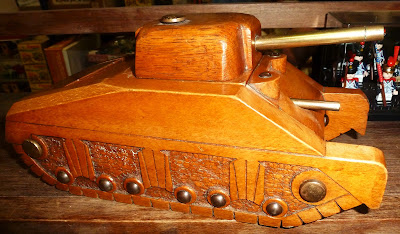Subsequent to this year's Plastic Warrior Show, Anthony has acquired the greater part of a Jacobite 54mm wargames collection created by our old friend Eric Kemp. Needless to say, we couldn't wait to get them out on the table. We turned to our default ruleset for such games, One Hour Wargames by Neil Thomas and selected Scenario 6 - Flank Attack.
This post is really a shameless opportunity to show off some very pretty toy soldiers, for which I offer no apology!
The scenario opens with the Jacobite army on the road home to Scotland, their path blocked by two units of Government troops, while another 4 units are approaching on the east flank.
The basic rules were tweaked to reflect national/tactical differences so that Highlanders have a longer move distance and can charge but not shoot they also gain a +2 in melee, regular infantry can move or fire but not both and can't charge.
This makes for a fast moving and very bloody game so we actually managed to play the scenario twice and this was the first game
Two units of Highlanders in the van followed by artillery and a unit of French allies (their only regular unit) approach the Government regulars.
The blocking Government troops get off a volley before they are hit by the Highlanders charge, once in melee they are unable to disengage.
The Government troops out on the flank include a unit of loyalist Lowlanders who have the same movement and combat features as the Highlanders.
The regulars and artillery on the flank advance into range and begin to pepper the attacking Highlanders.
The French regulars turn to face the threat from the flank.....
......and defend against the charging Lowlanders
The Highlanders have the advantage in melee but need to engage quickly before they take too much punishment from the musket volleys, flexibility in changing formation proved to be the key to the game.
In the second game the Government drew a unit of cavalry, together with the artillery they blocked the path of the Highland army.
Cavalry follow the standard OHW Horse and Musket rules, they can charge but if they do not eliminate the unit attacked they are bounced back half a move.
The collection includes Jacobite cavalry in the form of Bagot's Hussars but sadly they didn't get drawn when units were diced for, I think they would have made a substantial difference to the dynamics of the game.
With the Highlanders enhanced movement both sides moved rapidly into contact and very quickly became depleted in combat, these were without doubt the fastest OHW games we have played to date.
The Government troops carried the day in both games but they were each a very close run thing.
The figures themselves include a large number of conversions, particularly among the Highlanders, makers include: Replicants, Armies in Plastic, A Call to Arms, Accurate, Barzo, Marx, Cherilea and Timpo.


























































